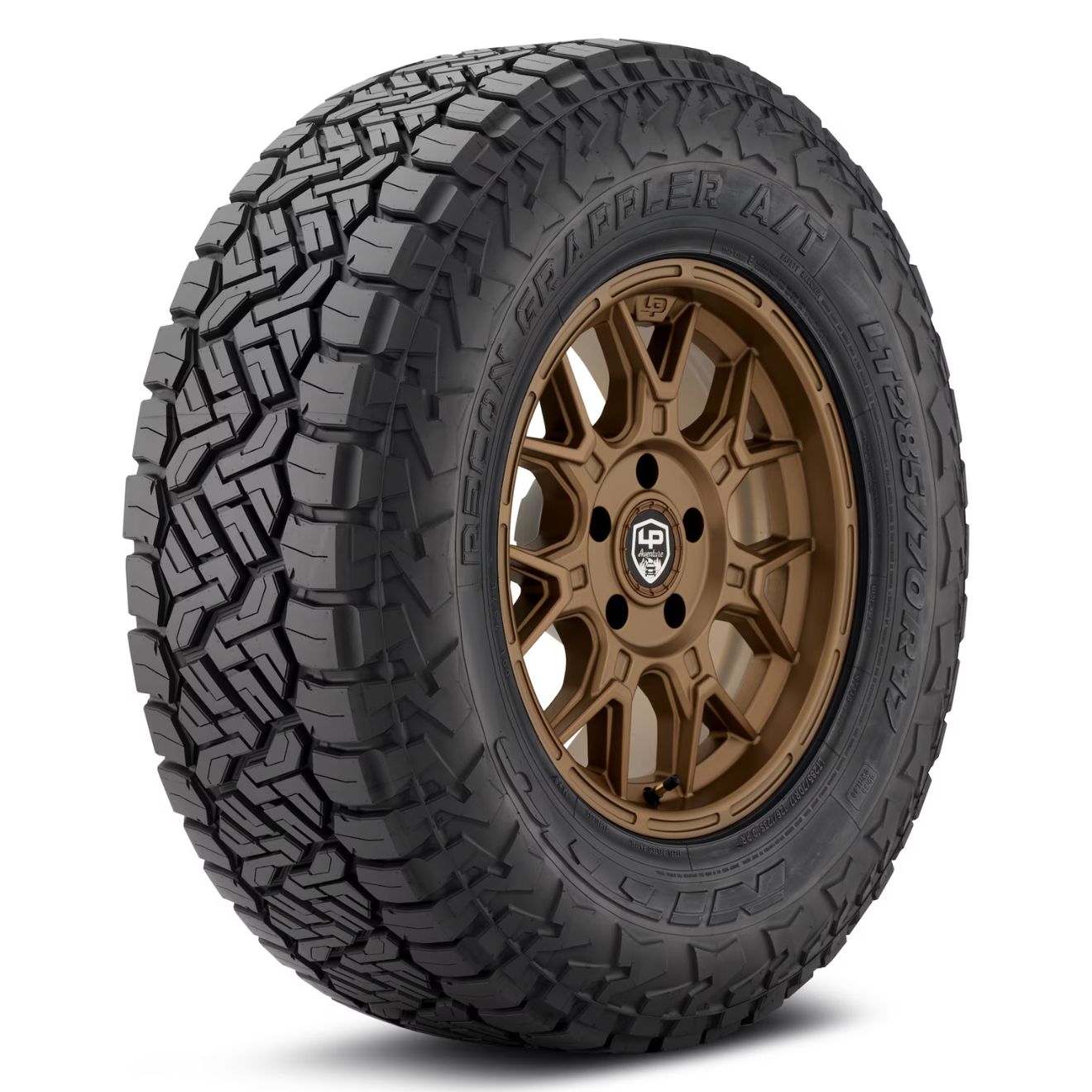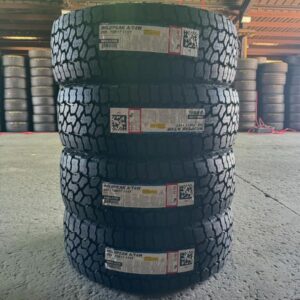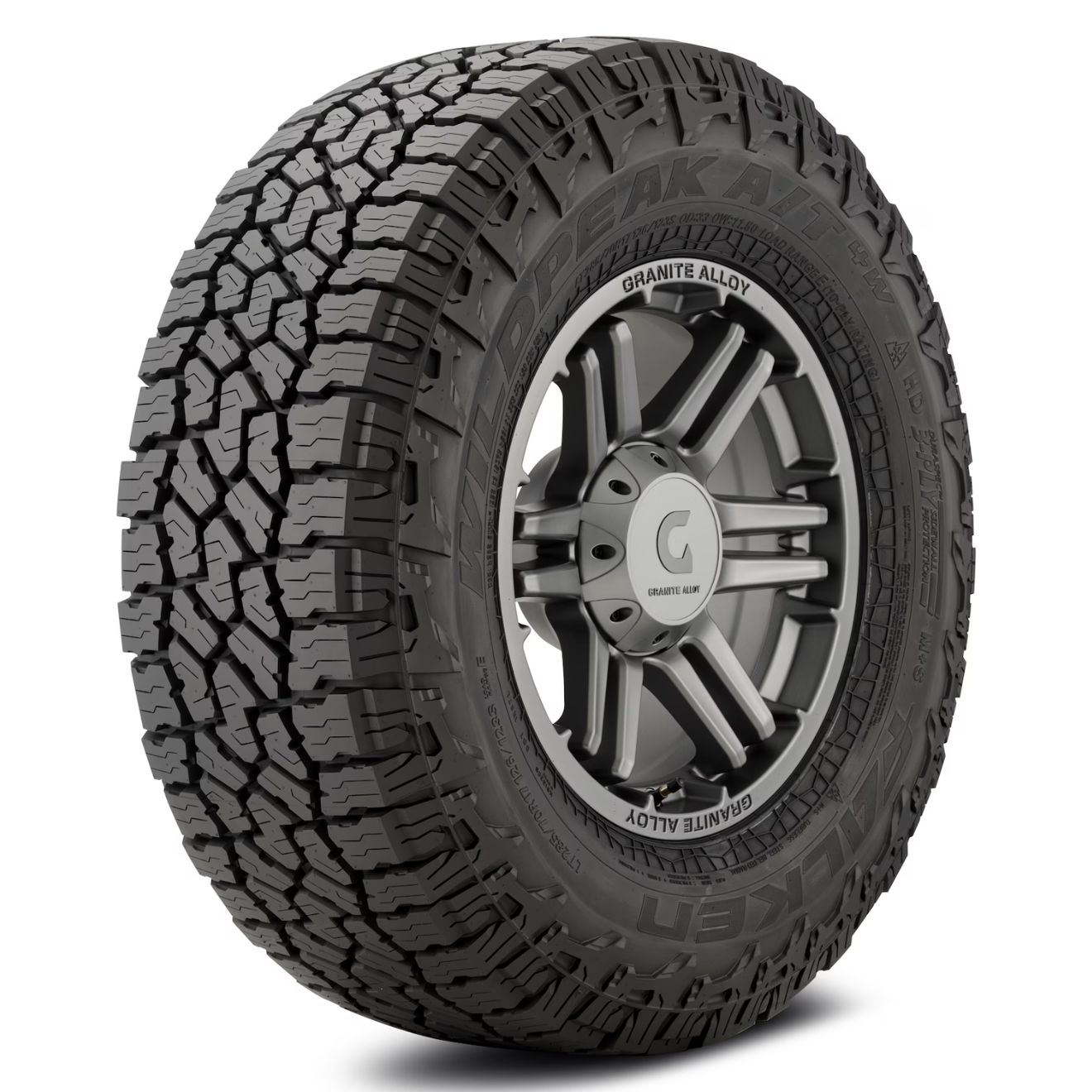Real-world test data, driver impressions, and community feedback — explained by a former Bridgestone test engineer.
The Nitto Recon Grappler A/T is a tougher, hybrid-leaning Off-Road A/T tire, built with a stiffer casing and blockier tread that shine under load and on gravel. The Nitto Terra Grappler, by contrast, is more road-friendly — tuned with a silica-rich compound and tighter tread pattern that feel safer in rain and more stable in winter. Snow-certified with the 3PMSF rating, the Terra Grappler G3 builds on the Nitto Terra Grappler G2’s reputation for all-weather reliability.
That’s the split buyers face — Recon for rugged stiffness and trail bite vs AT4W for winter stability and everyday drivability. In the sections ahead, I’ll show how they compare across dry, wet, snow, and off-road testing. You can also line them up in our All-Terrain Tire Decision Tool for quick, vehicle-specific recommendations by SUV, CUV, or truck class.
Quick Look
The Nitto Terra Grappler G3 is the calmer, more planted daily driver of the two. With a 127-ft dry stop and 0.74 g cornering, it steadies trucks through highway sweepers and delivers shorter wet stops (158 ft / 0.57 g) than many rivals. Drivers praise its “quiet, stable ride” and confidence in rain or packed snow, while its earlier ice grip adds an extra safety margin for commuters. It’s also the more comfortable choice, with an 8.0/10 ride score and less cabin hum. For suburban, snow-belt, and highway use, the G3 is the predictable, quiet A/T that makes winter commuting easier.
The Nitto Recon Grappler A/T leans the other way — more aggressive, more expressive. With a 138-ft dry stop and 0.72 g cornering, it feels sharper on initial turn-in but less settled under load. Wet and icy stops stretch longer, demanding more margin, yet drivers praise its rugged looks and note it “bites into mud and ruts” better than expected. Its off-road scores (8.2 dirt / 8.3 mud / 8.1 rock) easily top the G3, making it the go-to for overlanding and weekend trails. Road comfort takes a back seat (7.3/10), but the Recon delivers that hybrid A/T personality for drivers who want visual punch and real trail chops.
👉 Bottom line: Terra G3 = quiet commuter confidence; Recon = rugged hybrid with extra bite.
Nitto Recon Grappler A/T

Nitto Terra Grappler G3

Tire Decision Tool
For those in a hurry: this tool makes it easy. Just pick your vehicle and what matters most to you, and it’ll instantly suggest the best tire options.
Raw Test Data
Tire Test Data
Pick categories to show metrics, then open ☰ to pick tires. Optional chart is hidden by default.
Tread Pattern & Specs
Nitto Recon Grappler A/T
The Recon Grappler sits between an A/T and R/T. Its large, staggered shoulder blocks and deep voids provide biting edges for dirt and gravel, while its reinforced casing resists chips and cuts. This aggressive design explains its stronger dry grip and off-road stability, but also why it struggles in wet braking — wide voids don’t evacuate water as efficiently.
Nitto Terra Grappler G3
The Terra Grappler G3 is an on-road leaning A/T, with tighter tread blocks and abundant siping for water evacuation. Its shoulders are less aggressive, which improves ride comfort and noise levels. The design favors wet-road safety and long tread life, making it more of a commuter’s A/T than a trail-ready option.
Dry Performance — G3 more planted, Recon sharper off the line
On dry roads, G3 stops in about 127 ft / 0.74 g cornering, while Recon lags to 138 ft / 0.72 g. That means G3 feels more composed when you push it; Recon gives quicker initial bite but requires care under load.
Forum users often say things like Recon “looks great, a bit louder, but the steering feel is more responsive.” Others with G3 report “road hum is lower, truck feels more planted in highway sweepers.”
Engineering insight: G3 uses firmer shoulders and reinforced ribs to reduce block flex, which helps with line-holding and straight-line stability. Recon’s blocks are more aggressive, allowing sharper turn in, but at the cost of slightly more vibration and less stiffness under heavy cornering.
SUVs & crossovers: G3 feels more composed; Recon more playful.
½-tons: G3 steadier with trailers; Recon fun unloaded.
¾-tons & HD trucks: G3 better on long highway loads; Recon more likely to squirm under weight.
👉 Verdict: G3 wins dry stability; Recon wins snap and flair.
Wet Performance — G3 stops shorter, Recon needs margin
In the wet, G3’s stopping performance shines compared to Recon: G3 stops at ~158 ft / 0.57 g, Recon at ~192 ft / 0.43 g. That’s a meaningful difference when braking hard in a downpour.
From Tundra forums and Reddit, several users say G3 “feels confident in the rain, doesn’t dart or wander,” while Recon owners note “you learn to leave more space, it takes longer to scrub speed.”
Engineering side: G3’s compound and siping work better in wet films; its grooves evacuate water more efficiently. Recon’s tread voids and block design prioritize off-road strength and dry bite, so wet braking suffers comparatively.
SUVs & crossovers: G3 gives more margin in wet stops.
½-tons: Recon workable if careful; G3 safer.
¾-tons & HD: G3 keeps trailers safer under wet emergency braking; Recon demands more planning.
👉 Verdict: G3 is the safer wet pick; Recon trades wet performance for off-road/off-dry aggression.
Note from the Expert: When it comes to rain, I always emphasize two things: compound grip and water evacuation. You can see the full details in my analysis, but if you take just one thing away, remember that an AT tire’s stiff nature makes achieving top-tier wet performance a constant battle. This is why the question, Are All-Terrain Tires Good in Rain?, requires a nuanced answer that balances tread design against rubber stiffness.
Winter & Snow — G3 control, Recon depth vs polish trade-offs
Snow tests have G3 with ~86.9 ft snow stop / 45.2 ft snow accel, while Recon offers ~74.0 ft stop / 45.5 ft accel. That gives Recon a slight edge in launch out of snow, but G3 stops sooner when snow or slush is packed.
Forum voices reflect that: Recon drivers say “good pull in loose snow but far from polished,” while G3 users describe “predictable braking in snow, especially on plowed roads.”
Engineering nuance: Recon uses more aggressive tread block edges and deeper voids that help when digging out of fresh snow. G3’s compound and tighter siping favour packed snow braking and more control once the road has been cleared.
SUVs & crossovers: G3 offers better stability in snow-belt roads; Recon better for deep snow, less plowed environments.
½-tons: Recon gives more pull in fresh snow; G3 offers safer, shorter stops on maintained routes.
¾-tons & HD trucks: G3’s braking comes through under load; Recon might carry momentum but needs more tire to stop.
👉 Verdict: Recon edges in snow acceleration; G3 stronger where snow is packed or roads are plowed.
Note from the Expert: Our discussions often boil down to the core tradeoff. On one hand, you must understand why all-terrain tires are truly effective in deep snow, but not on ice. On the other hand, you face the 3PMSF Paradox—the hidden cost of that badge. The short answer is: The 3PMSF badge certifies traction, but it costs you durability. Dive into our full analysis on the critical 3PMSF rating for severe winter and off-road service, and its hidden costs, before you risk your rig on the trail.
Ice — G3 has more margin, Recon slides longer
On icy surfaces, G3 stops around 47.8 ft, while Recon stops around 46.5 ft. The numbers are close, but the feel is different: G3 feels more secure early in the stop, Recon tends to slide more before catching grip.
Users say G3 gives “confidence on morning frost,” while Recon owners warn “require gentler braking, especially downhill.”
Engineering explanation: G3’s sipes and harder-shoulder compound help hold micro-edges in freezing temps; Recon, with more aggressive block geometry, loses those edges earlier under load, increasing slide before bite.
SUVs & crossovers: G3 safer on ice; Recon manageable if driving conservative.
½-tons: G3 gives extra margin; Recon requires planning and speed control.
¾-tons & HD: G3’s sturdier build helps under load; Recon can be unpredictable in ice with heavy weight.
👉 Verdict: G3 wins ice control; Recon riskier unless constrained.
Off-road scores show Recon at 8.2 dirt / 8.0 sand / 8.3 mud / 8.1 rock, while G3 logs 6.8 / 6.8 / 6.5 / 6.7. Recon is the better tool when trails get rough, mud gets deep, or you’re airing down for rock. G3 prefers gravel, fire roads, and softer terrain.
Forum feedback: Recon users rave its grip in mud and rough terrain; G3 owners praise how it handles gravel and stone without harsh ride or noise. One G3 driver said “things bounce less, ride feels more stable than expected off-road.”
Engineering view: Recon’s deeper voids, larger tread block edges, and reinforced sidewalls resist chunking and tear. G3 trades off some of that brutality for smoother tread contact, less harshness over washboards, and less vibration.
SUVs & crossovers: G3 plenty for mild trails; Recon when you expect real off-road.
½-tons: Recon gives more capability off-road; G3 for occasional dirt and lighter terrain.
¾-tons & HD: Recon built for this use; G3 may feel under-engineered when abused.
👉 Verdict: Recon wins off-road capability; G3 wins smoother trail manners.
Note from the Expert: Every successful day on the trail is about preparation and physics, because tire longevity is earned, not given. Before you even start, you must master the critical link between tire pressure and load range for every rig to maximize your contact patch. Once moving, remember your ultimate off-road armor is your sidewall protection against the inevitable pinch flat. And finally, your traction on the obstacle is dictated by choosing the right aggressive vs hybrid tread pattern for your terrain. Master those three steps, and your rig will be ready for anything.
Comfort & Noise — G3 quieter, Recon more rugged feel
G3 comfort scores ~8.0/10, Recon ~7.3/10. G3 owners frequently say “ride is phenomenal and noise is minimal,” while Recon users report more noise at highway speeds and more road texture felt.
Engineering cause: G3’s tread ribs and lower void ratio reduce high frequency resonance. Recon’s aggressive block layout and stiffer shoulders generate more vibration, especially on pavement.
SUVs & crossovers: G3 clearly more comfortable.
½-tons: Recon tolerable but louder; G3 easier on long drives.
¾-tons & HD: Noise blends with load, but G3 still wins comfort baseline.
👉 Verdict: G3 is the comfort pick; Recon trades quiet for toughness.
Note from the Expert: For years, choosing all-terrain meant accepting noise—a true compromise for off-road grip. That’s why the question, Are All-Terrain Tires Louder than Highway Tires?, used to have a simple “yes” answer. Now, with the rise of on-road models, the core issue has shifted from noise to overall refinement. To fully understand which side of the comfort spectrum you’re buying into, you need to determine Are All-Terrain Tires Good for Daily Driving?—a question that depends entirely on the tire’s construction, not just the name.
Where They Fit Best + Regional Notes
Nitto Terra Grappler G3: Best for drivers who want a strong all-terrain tire with better wet & snow braking, highway manners, and quieter ride. Great fit for urban/suburban highways, snow-belt roads that are plowed, and lighter rigs that see occasional trail or dirt.
Nitto Recon Grappler A/T: More aggressive capability, better for serious trail work, mud, gravel, and mixed terrain that’s rough. Ideal for mountain regions, desert roads, or weekend overland use where on/off-road balance is asked.
👉 Bottom line: G3 wins stability, wet/ice margin, and road comfort. Recon wins raw grip off-road and aggressive look, at expense of noise, wet/ice margin, and ride smoothness.
Tire Size Selection: The Basics You Can’t Skip
Even the best tread design can’t rescue a tire that’s built too weak. Back when I was testing tires at Bridgestone, I saw all-terrain models that should’ve performed but fell short — simply because the basics (size, load strength, and speed rating) weren’t matched to the vehicle.
P-Metric vs. LT (Light Truck) Tires
The first step is knowing whether you need LT or passenger tires. LT (Light Truck) tires are built with extra reinforcement and stiff sidewalls, designed for towing, hauling, or off-road use. Passenger (P-metric) tires are lighter, smoother, and tuned for daily comfort and fuel efficiency — but they’ll flex more under load.
Understanding Tire Load Range: XL vs. E-Load
Then comes the tire load index and load range — essentially your tire’s strength rating. Here’s where things split between passenger XL and LT E:
XL (Extra Load) is a passenger tire with reinforced sidewalls. It can handle a bit more pressure (~41 PSI) than a standard SL tire and is perfect for SUVs, crossovers, or light trucks that carry extra gear, passengers, or small trailers. XL tires ride softer and quieter than LT options, making them ideal for daily use.
E Load Range is an LT tire class built with a much thicker casing. E-rated tires can handle far more pressure (up to ~80 PSI) and heavier loads, which makes them essential for ¾-ton and 1-ton trucks towing trailers or hauling close to max capacity. The trade-off is weight, stiffer ride, more road noise, and a small drop in fuel efficiency.
Put simply: XL is for “extra luggage and family,” while E is for “truck bed full of bricks or a car trailer.”
Why the Tire Speed Rating Matters for Safety
Finally, don’t overlook the tire speed rating. It’s not just about top speed — it measures how well a tire handles heat and stress at highway pace. Lower ratings (like S) tend to ride softer and last longer, while higher ratings (H, T) feel more stable and responsive under sharp maneuvers. Heat build-up is the silent killer of tires, and speed rating is your safeguard.
Bottom line: Match your tire’s construction (LT vs P-metric), load range (XL vs E), and speed rating to your vehicle’s demands. Get those right, and everything else — off-road grip, winter traction, comfort — will finally perform the way it was designed to.
Final Verdict
Pick the Terra Grappler G3 if you want safety, composure, and quietness above all. It’s better for plowed roads, rain-soaked highways, and drivers who value predictable handling in winter conditions. SUVs, crossovers, and ½-tons used mainly for commuting or light trails feel at home on G3s.
Choose the Recon Grappler A/T if off-road grip, looks, and responsiveness matter more than wet/ice security. It’s a better fit for mountain, desert, or mud-heavy regions where trail grip outweighs comfort. Best on ½-ton and ¾-ton pickups that spend weekends in rougher terrain.
👉 Bottom line: G3 is the refined, wet-safe commuter A/T; Recon is the sharper, off-road-ready hybrid that trades polish for grit.
Frequently Asked Questions: Nitto Terra Grappler G3 vs Nitto Recon Grappler A/T
Which tire is better on dry roads?
The G3 stops shorter (127 ft / 0.74 g) and feels more planted, while Recon reacts sharper but is less steady under load.Which tire performs better in the rain?
The G3 is safer, stopping at 158 ft / 0.57 g, while Recon stretches to 192 ft / 0.43 g and requires more braking distance.Which tire is stronger in winter and snow?
G3 brakes shorter on packed snow and feels steadier on plowed roads. Recon digs better in loose drifts but runs longer on salted pavement.How do they compare on ice?
G3 feels more secure early in stops, while Recon tends to slide longer before regaining grip.Which tire is better off-road?
Recon clearly wins with higher dirt, mud, and rock scores. G3 is smoother on gravel and fire roads but not built for rough trails.Which tire is quieter on the highway?
The G3 is quieter and smoother (8.0/10), while Recon is louder (7.3/10) with more road texture.Who should buy the Terra Grappler G3?
Commuters and light-trail drivers who want a quiet, predictable tire for rain, snow, and highway driving.Who should buy the Recon Grappler A/T?
Drivers who value aggressive looks, sharper steering, and stronger off-road performance, even at the cost of comfort and wet/ice security.










